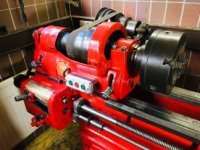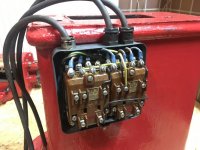Marco Schwan.
Plastic
- Joined
- Jan 18, 2020
Heyho!
I've been meaning to get a metal Lathe for a few years now; but it was always low on the priority list.
But I do keep looking at e.g. ebay from time to time for new offers.
This one I just couldn't resist. Price was 350€
I got myself an "Ehrlich" Brand Lathe from 1928(!).
Unfortunately there is Zero information about it online (apart from a written article), and It didn't come with any manual. If anyone has any information on it, that would be awesome!
The previous owner had it in his garage over decades, practically unused. If anything he was using it to turn wood with it, not metal.
This meant that it was in near perfect condition. No rust, no obvious bent/missing pieces, etc.
Upon disassembly I also found that there was not a single tiny metal chip anywhere in the machine, not even in very hard to clean places.
I have documented the restauration process and made a video of it, for anyone interested. Link below.
I am pretty new to the whole metal machining world, infact this is my very first metal machining-machine. Any tips would be helpful!
Here are some Photos and specs of the machine:
Length between centers: 110cm (42")
Max Diameter: 38cm (15")
Max Diameter with bed section removed: 65cm (25.5")
Spindle bore: 5cm (2")
2.2Kw (3hp) 3-Phase Motor, 400V @1500rpm - forward and reverse
4 speeds via flatbelt ~110rpm-800rpm
36-Speed Screwcutting Gearbox
Seperate Threadcutting and Surface power shafts.
Weight roughly 700Kg (1550lbs)





I know that, for a beginner, it may not be the perfect first Lathe, beeing that old. Missing some features that are just a given on newer lathes now. I hope to get some good use out of it though.
One big question I have is about the bearings, or should I say bushings. The Spindle is running in huge tapered bronze(?) bushings. I tried my best to set a preload on them, while still having them run easily - So far its all seeming okay, but the front bearing stays completely cool while the back one gets ever so slightly warm (after about 1 hour runtime). Its not even warm enough to call it lukewarm, but its not cold anymore. Any tips on that?
I hope I did this old Lady justice in restoring it and bringing it back to life.
Video: YouTube
I've been meaning to get a metal Lathe for a few years now; but it was always low on the priority list.
But I do keep looking at e.g. ebay from time to time for new offers.
This one I just couldn't resist. Price was 350€
I got myself an "Ehrlich" Brand Lathe from 1928(!).
Unfortunately there is Zero information about it online (apart from a written article), and It didn't come with any manual. If anyone has any information on it, that would be awesome!
The previous owner had it in his garage over decades, practically unused. If anything he was using it to turn wood with it, not metal.
This meant that it was in near perfect condition. No rust, no obvious bent/missing pieces, etc.
Upon disassembly I also found that there was not a single tiny metal chip anywhere in the machine, not even in very hard to clean places.
I have documented the restauration process and made a video of it, for anyone interested. Link below.
I am pretty new to the whole metal machining world, infact this is my very first metal machining-machine. Any tips would be helpful!

Here are some Photos and specs of the machine:
Length between centers: 110cm (42")
Max Diameter: 38cm (15")
Max Diameter with bed section removed: 65cm (25.5")
Spindle bore: 5cm (2")
2.2Kw (3hp) 3-Phase Motor, 400V @1500rpm - forward and reverse
4 speeds via flatbelt ~110rpm-800rpm
36-Speed Screwcutting Gearbox
Seperate Threadcutting and Surface power shafts.
Weight roughly 700Kg (1550lbs)





I know that, for a beginner, it may not be the perfect first Lathe, beeing that old. Missing some features that are just a given on newer lathes now. I hope to get some good use out of it though.
One big question I have is about the bearings, or should I say bushings. The Spindle is running in huge tapered bronze(?) bushings. I tried my best to set a preload on them, while still having them run easily - So far its all seeming okay, but the front bearing stays completely cool while the back one gets ever so slightly warm (after about 1 hour runtime). Its not even warm enough to call it lukewarm, but its not cold anymore. Any tips on that?
I hope I did this old Lady justice in restoring it and bringing it back to life.
Video: YouTube







